GS 350 puts stealth Lexus on the street
By John Gilbert
LAS VEGAS, NEV. — On my first lap around the special cone-lined handling course Lexus had set up at Las Vegas Speedway, I powered the Lexus GS 350 through a 90-degree left turn when, facing a bit of a straight chute, something caused me to glance upward. A pair of sleek jet fighter planes, cruising in to land at the nearby Air Force base, glided across my line of vision.
I told the Lexus folks that was unnecessary inspiration. We were sufficiently fired up to drive the 2013 mid-luxury GS models hard enough around the handling course and the adjacent autocross, although I had to admit, watching those F-18 and Stealth fighter planes circling above pushed us to push this new sports-luxury sedan to its limits.
Anticipation for a Lexus introduction is often of technology in a softly comfortable car that is extremely competent, with strong engineering, but stressing luxury and amenities more than performance. The GS has been a Lexus holdout, however, always striving to be a European-like sedan that added sporty performance to Lexus, Toyota’s luxury division.
I suggested that Toyota had better watch its step. First, the compact Lexus IS-F is a blast to drive, and then, in the never-ending duel of base models on the Toyota side, the new 2012 Camry quietly goes past the Honda Accord in sportiness by firming things up and offering its 4-cylinder with a 6-speed automatic and steering-wheel paddles — two sporty features unavailable on the Accord. Now comes the new-for-2013, fourth-generation GS350, impressive in base form, spectacular in F-Sport, and futuristic with its GS450h hybrid alternative. This all could ruin that soft, luxurious image, which Lexus has developed. No chance of that, however, because the GS impressively improves its sporty performance and handling with numerous engineering and performance tactics, without overlooking any luxury concepts.
The GS remains basically a rear-drive sedan as if that alone assures sportiness, but Lexus covers all wheels, as well as bases, by offering optional all-wheel drive, and even all-wheel steering. In combination, all of that thrusts the GS 350 into valid competition with the mid-level German performance sedans, such as the BMW 5-Series, Mercedes E-Class, and Audi A6. And the F Sport version infringes on territory previously reserved for the M5, AMG, and S6 models of those German counterparts.
The standard GS 350 is well-equipped in basic form, with plenty of standard features, starting with 17-inch alloy wheels, 10-way power seats, and the creature comforts Lexus buyers expect, all wrapped in a new body with what Lexus says is the new “spindle†grille that will become a Lexus signature, on an altered platform that once held the Supra and the SC 430.
The car will reach showrooms in February, which is when prices will be divulged. It will come only with a 3.5-liter V6 engine, but it is plenty potent, kicking out 306 horsepower at 6,400 RPMs (red-line 6,600), and 277 foot-pounds of torque at 4,800. It places fuel injectors both in the combustion chamber and the air-fuel runners, giving it both direct and port injection, but it wants costlier 91-octane premium fuel.
The major variations of the GS 350 are to pick the Premium package, which adds 18-inch wheels, rain-sensing wipers, heated and ventilated front seats, and a power rear sunshade. The Luxury package — remember, “Luxury†ranks above “Premium†in Lexus lexicon, which we can call Lexus-con — will get you everything on the Premium list, plus adaptive suspension, adaptive headlights, 18-way power seats, and rear heat-air controls.
The F Sport, with its available 19-inch wheels, with 235/40 front and 265/35 rear tires, uses the same V6 power, with standard four-wheel steering. But it looks meaner, with a mesh grille and retuned suspension with firmer springs, variable dampers, thicker stabilizer bars, variable gear ratios, altered bushings on the shock components, and bigger and stronger front brakes, and stark interior features, with 16-way power seats.
Leaving the same V6 as F Sport engine didn’t cause any dissatisfaction among the auto journalists in my group, who were first to drive the GS models around the autocross and handling courses, and out on the surrounding streets.
“We offered V8s in the past, but over 90 percent of buyers in this segment did not choose V8s,†said Charles Hubbard, director of Lexus College, the company’s department that offers scholarly explanations of all things automotive for the brand. “So we chose to stick with the V6 and Hybrid models. But I think you’ll find the driving dynamics are incredible.â€
Strong words, from a luxury car-maker, but the GS 350 made believers of us. Performance doesn’t just mean 0-60 acceleration, of course, it also means steering, handling, stability, braking, and the feeling that the car is responding instantly to driver input. That’s why the chance to hammer the cars around the autocross and handling tracks was beneficial, because we drove the cars much more aggressively than any sane driver would, on normal roadways, and they never even winced.
The GS 350 Luxury model with all-wheel-drive instead of the standard front-engine/rear-wheel drive gives it a distinct advantage for drivers in the snow-belt. It’s getting to be that time. Returning from Las Vegas to Minnesota after the introduction, I found the season’s first serious snowfall, which was only a couple of inches but instantly brought to mind the benefits of AWD, and the relative concerns drivers must consider about front-engine/rear-drive. News reports said the first snowfall, on the first weekend in December, helped facilitate 189 accidents overnight. Minnesota is the ideal location to learn proper winter-driving tactics by total immersion, but it seems that it takes a storm or two before even the locals reacquire their winter-driving sensitivity.
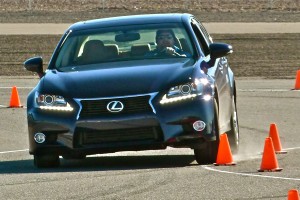
A firm platform and improved suspension allowed cutting close to the cones at the Las Vegas Speedway autocross.
All-wheel drive is not available on the F-Sport, although Lexus officials acknowledged that it could be added after the new model gets its legs, so to speak. As it is, the F Sport, subtly set apart visually from the other models, is loaded with high-technology devices, including all-wheel steering. The system causes the rear wheels to turn up to 2-degrees in the opposite direction of the steering angle of the front wheels, so if you’re making a left turn, you steer left and the rear wheels turn slightly to the right, causing the car to feel as though it is almost pivoting, for better response during urban cornering, or parking. Once above 50 mph, that could be dangerous, so at that point, the rear wheels turn up to 2 degrees in the same direction as the front. The effect is that a small movement of the steering wheel prompts the car to veer quickly into the next lane.
The system worked well on the autocross course, although it was not a very challenging layout, with mostly straight chutes and 90-degree turns instead of the usual tight switchbacks. Accelerate hard at the start, then brake hard for a 90-degree right, onto another straight before another 90-degree turn. It was basically accelerate hard, brake hard, turn and accelerate hard again. My times were OK, just under the 36-second range, until my last 2-lap try, when I managed a 34.5 that was the best of our group. Not that there was any competition except against yourself, and, by chance, it was beaten by another driver as I was walking away from the course.
Paddle shifters are a personal favorite of mine, because they give you fingertip control to override an automatic transmission with your hands on the wheel. In the GS 350, you can downshift by pulling the left-side paddle anytime, and if you shift into “M†you must upshift manually by pulling the right-side paddle. Just to verify that this is a street sedan and not a race car, the GS 350 is insulated from inattention, or having the surround-sound audio turned too loudly, by shifting itself if you reach redline without hitting the paddle. It also upshifts automatically if your speed decreases after hard acceleration.
The paddles are great for normal driving, and fun on the autocross and the more-wide-open handling course, but quick turns of 90 degrees makes you alter your hands on the wheel, making it easy to lose the location of the paddles. I used the floor-shifter’s manual gate instead, and gained new appreciation for the Mitsubishi Evolution, which has long paddles right and left affixed them to the steering column, rather than the wheel, so you always know where to find them for instant up- or downshifts. The Infiniti G37 also has copied that system.
Lexus has 7-speed and 8-speed automatics, but it uses a 6-speed in the GS models, with the explanation that more gears in a sportier car would cause an undue amount of hunting and shifting in normal traffic.
The all-wheel drive system has an electronic center differential that responds to driving conditions before determining whether to send torque front or rear on a 50-50 or up to 30-70 proportion.
The hybrid GS 450h uses the same 3.5 V6, with an Atkinson Cycle application that modifies valve overlap for optimum efficiency. It reduces horsepower to 286, but the 450h gets the equivalent of 52 more horsepower from its upgraded nickel-metal hydride battery pack for a total of 338 horsepower. The hybrid also is strictly rear-drive, but it will run on the gas engine, electric power, or both — unlike the Toyota Hybrid Synergy Drive system, which runs on electric power only, with even the gas-engine power forced through a generator to make electric drive-power.
An adjustable drive mode makes the GS more sporty, whether normal or hybrid. You can click a switch on the console to Eco, which gives you blue-lighted instruments, and automatically adjusts climate-control and seat heaters to aid optimum fuel economy. Switch to Sport-S, and you find the throttle response and shift-mapping quickened over the normal, with the torque-converter locking up earlier, while the gauges glow red instead of blue. The maximum setting is Sport-S+, which is available only on Luxury package and F-Sport models, and engages the adaptive variable suspension, adaptive steering, and changes the amount of intervention by VDIM, which could be loosely translated to “traction and stability control coordination,†but is more accurately the Vehicle Dynamic Integrated Management system.
The use of more high-strength steel, laser welding, plus improved cross-members, has reduced flex and helped improve stiffness of the chassis. That aids the sporty settings of the double-wishbone front suspension and multi-link rear, with their adaptive variable adjustment to control roll and pitch.
A cold-weather package includes heated steering wheel along with heated front and rear seats, a headlight washer, wiper de-icers, and water-repellent front door glass.
On the luxury side, the GS 450h leads the way with specific light bamboo interior trim and steering wheel that is worth sitting in, just to feel it. All models get remote touch control of the panoramic 10.3-inch navigation screen that can be divided into three segments. You can adjust LED lighting for ambience when the doors are opened, and the sensors for detecting rain are built into the windshield.
The pre-collision system includes a driver-attention monitor, which fixes on the driver’s eyelids. If you get drowsy and your eyelids sag, it warns you. The dynamic radar cruise-control also has a lane-keep assist to prevent wandering to the adjacent lane without signaling, and it has a night-view feature for detecting things ahead in the dark, and a heads-up display of car readings on the windshield.
After putting the GS 350 through its paces, I looked up at a Stealth fighter circling without any symbols on it, and wondered about it. No matter how much secret stuff is on that plane, can it have more high-technology equipment than the GS 350 F-Sport?
Comments
Tell me what you're thinking...
and oh, if you want a pic to show with your comment, go get a gravatar!


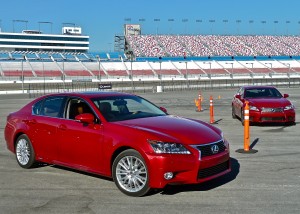
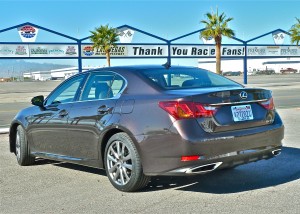
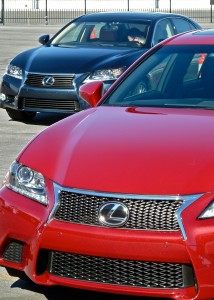
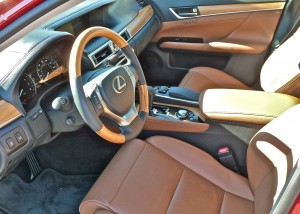
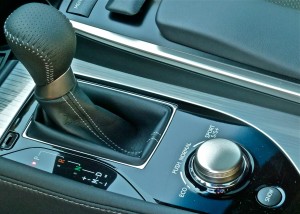
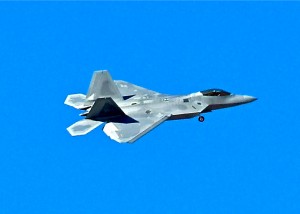
 John Gilbert is a lifetime Minnesotan and career journalist, specializing in cars and sports during and since spending 30 years at the Minneapolis Tribune, now the Star Tribune. More recently, he has continued translating the high-tech world of autos and sharing his passionate insights as a freelance writer/photographer/broadcaster. A member of the prestigious North American Car and Truck of the Year jury since 1993. John can be heard Monday-Friday from 9-11am on 610 KDAL(www.kdal610.com) on the "John Gilbert Show," and writes a column in the Duluth Reader.
John Gilbert is a lifetime Minnesotan and career journalist, specializing in cars and sports during and since spending 30 years at the Minneapolis Tribune, now the Star Tribune. More recently, he has continued translating the high-tech world of autos and sharing his passionate insights as a freelance writer/photographer/broadcaster. A member of the prestigious North American Car and Truck of the Year jury since 1993. John can be heard Monday-Friday from 9-11am on 610 KDAL(www.kdal610.com) on the "John Gilbert Show," and writes a column in the Duluth Reader.